本紹介内容は[MDPI]が発行した["Phase Field Simulation of Al–Fe–Mn–Si Quaternary Eutectic Solidification"]の研究内容です。
![Figure 1. (a) Liquidus projection of the Al-Fe-Si ternary system and (b) Al-Mn-Si ternary system [28].](https://castman.co.kr/wp-content/uploads/image-1343-1024x429.webp)
1. 概要:
- タイトル: Phase Field Simulation of Al–Fe–Mn–Si Quaternary Eutectic Solidification
- 著者: Kimiya NouraniNiaki, Murali Uddagiri, Daysianne Isidorio, Oleg Shchyglo, and Ingo Steinbach
- 出版年: 2025年
- 出版ジャーナル/学会: Metals
- キーワード: アルミニウム; 凝固; 金属間化合物; 四元系; マルチフェーズフィールド

2. 概要 / 導入
本研究では、多成分系における共晶平衡相を3次元マルチフェーズフィールドシミュレーションによって調査します。方向凝固プロセスを強調し、金属間化合物相Al13Fe4、ラメラ構造(FCC-A1)、および特定の温度で凝固された液体からの四元相ベータ-AlMnSiの成長ダイナミクスを検証します。4相反応L → Al13Fe4 + FCC-A1 + ベータ-AlMnSiによって記述される共晶変態を解析し、微細組織選択マップを作成します。このマップは、安定な成長モードと初期系組成およびラメラ間隔を関連付けます。結果は、合金元素の偏析挙動と変態速度論への影響に関する詳細な洞察を提供し、複雑な合金系における共晶微細組織の進化の理解を深めます。
3. 研究背景:
研究トピックの背景:
アルミニウム合金は、優れた機械的特性と持続可能性の潜在力により、自動車、航空宇宙、輸送産業で広く利用されています。環境持続可能性に対する世界的な重視の高まりとアルミニウム合金の需要の増加は、リサイクルアルミニウム合金を組み込むことで効果的に対処できます。このアプローチは、生産コストを削減するだけでなく、エネルギー消費も削減します。一般的に使用されるアルミニウム合金の中でも、3000系は軽量性、高い機械的強度、優れた成形性[1]で注目されています。Fe、Mn、Siなどの主要な合金元素は、これらの特性を向上させる上で重要な役割を果たします。Feはダイカスト中の金型焼き付きを防止し[2]、Siは液相流動性を向上させ[3,4]、Mnは金属間化合物を安定化させ[5,6]、それによって機械的特性を向上させます。しかし、これらの元素の適切な組成を選択することは重要であり、重量分率を超えると脆い金属間化合物[7]の形成につながり、機械的性能に悪影響を与える可能性があります。したがって、相形成の有効な制御は、設計および製造中のアルミニウム合金の機械的特性を最適化するために不可欠です[8-11]。
既存研究の現状:
多成分合金の広大な組成空間を探求するために、凝固および平衡条件下での相挙動を予測するために計算手法が用いられています。熱力学モデルは、アルミニウム合金を設計するための貴重なツールです[12,13]。CALPHADアプローチは、アルミニウム合金の材料設計およびプロセス最適化に広く使用されています[1,14]。CALPHAD法の強みは、多成分系における熱力学的挙動を予測するために自己整合性のあるパラメータを使用できることにあります[8,15]。フェーズフィールドモデリングは、凝固[16]、偏析[17-19]、粒成長[20]などの複雑な系をシミュレートする別の計算アプローチであり、熱力学的に基礎付けられた偏微分方程式[21]を使用します。熱処理中の析出物の形態、サイズ、体積分率、および空間分布の変化を正確に予測することは、析出硬化効果を理解するために重要です。Al2Cu析出物のようなメソスケールシミュレーションは、これらのプロセスへの洞察を提供します[22]。フェーズフィールド法、特に拡散界面アプローチを用いたものは、明示的な界面追跡の必要性をなくすことでモデリングを簡素化します[21]。熱力学モデルによるアルミニウム合金の理解と設計は、数値シミュレーションによって強化されます。これらのモデルにより、微細組織の進化に影響を与えるさまざまな要因の分析が可能になります[22-27]。しかし、アルミニウム合金における明確な四元相の証拠は限られています。例えば、α-AlMnSi相は四元系に大きく広がり、三元系Al-Fe-Si系に近づいていますが、Al-Fe-Mn-Si系のアルミニウムリッチコーナーには安定な四元相は存在しません[28]。計算熱力学とマルチフェーズフィールドモデルを組み合わせることで、多成分系における相分布の詳細な分析が可能になります。Warmuzek [29]によれば、棒状のFCC-A1形態は、2つの主要な反応を伴う共晶変態を通じて形成される可能性があります。しかし、多成分アルミニウム合金における四元相に関する実験データは依然として不足しています。さらに、Al13Fe4は、Al-Fe-Mn-Si系において、Al基合金の微細組織と特性に影響を与える重要な金属間化合物相です。この相は、Al-Fe-Si系のAlリッチコーナーに形成される唯一の平衡相であり、共晶反応の一部として凝固中に形成されます。この相は、リサイクルアルミニウム合金で特に一般的であり、鉄はアルミニウムへの溶解度が低いため蓄積する傾向があります。Quan Liら[7]によって報告されているように、Al13Fe4金属間化合物相は、応力集中源として作用し、延性と耐食性を低下させることにより、鉄含有量の多いリサイクルアルミニウム合金の機械的特性に悪影響を与えます[30]。したがって、この相の形成、形態、および他の金属間化合物との相互作用を理解することは、その有害な影響を軽減する合金を設計するために不可欠です[31]。このような研究は、アルミニウム合金の構造性能、リサイクル性、機械的特性、および耐食性の向上に貢献します[32]。
研究の必要性:
本研究の目的は2つあります。第一に、四元相ベータ-AlMnSiの出現につながる主要な反応を介して形成される共晶固相の微細組織選択マップを開発すること。第二に、フェーズフィールド法を用いて、四元相を定性的および定量的に特徴付けることです。本研究では、FCC-A1のラメラ構造、金属間化合物析出、微細組織の進化、および四元相としてのベータ-AlMnSiの空間分布に焦点を当てています。これらの調査は、マルチフェーズフィールドシミュレーションを通じて実施され、複雑な共晶系における微細組織形成を支配するメカニズムの包括的な理解を提供することを目的としています。
4. 研究目的と研究課題:
研究目的:
本研究の目的は2つあります。第一に、四元相ベータ-AlMnSiの出現につながる主要な反応を介して形成される共晶固相の微細組織選択マップを開発すること。第二に、フェーズフィールド法を用いて、四元相を定性的および定量的に特徴付けることです。
主要な研究:
本研究は以下に焦点を当てています。
- FCC-A1のラメラ構造
- 金属間化合物析出
- 微細組織の進化
- 四元相としてのベータ-AlMnSiの空間分布
これらの調査は、マルチフェーズフィールドシミュレーションを通じて実施され、複雑な共晶系における微細組織形成を支配するメカニズムの包括的な理解を提供することを目的としています。
5. 研究方法
研究デザイン:
本研究では、方向凝固プロセスを強調し、多成分系における共晶平衡相を調査するために、3次元マルチフェーズフィールドシミュレーションを採用しています。本研究で採用されたモデルは、Steinbachら[21,46]によって開発されたマルチコンポーネントマルチフェーズフィールド(MPF)モデルであり、OpenPhaseソフトウェアバージョン4.7を使用して実装されています。シミュレーションでは、60 × 60 × 120グリッドセル、グリッド解像度1 × 10−7 mの3Dボックスを考慮しました。
データ収集方法:
熱力学情報は、Thermo-Calcソフトウェアバージョン2021bに実装されたCALPHAD法を使用して、COST-507データベースから取得されます。システム温度は、一定の温度勾配と冷却速度[47]を考慮した凍結温度法を使用して更新されます。核生成は、核形成の障壁を超える局所的な駆動力に関連するAL Greerのアプローチ[49,50]に基づいてモデル化されました。
分析方法:
フェーズフィールド法[40]は、相変態中の材料の微細組織進化をモデル化するために使用される確立された数値シミュレーション技術です。この方法では、「拡散界面モデル」を採用して、相間の相互作用を解決します。マルチフェーズフィールド(MPF)モデルは、相全体の溶質組成の進化を表す拡散方程式を組み込んでいます。熱力学的最小化は、相フィールドから導出された混合組成と個々の相分率に基づいて相濃度を決定するために不可欠です。
研究対象と範囲:
表3に示すように、四元系Al-Fe-Mn-Si系の公称組成は、実験的参考文献[51]から導出されています。シミュレーション領域のサイズが限られているため、シミュレーション領域は単一結晶粒内の複数のデンドライト成長のスケールに制限されています。研究は、4相反応L → Al13Fe4 + FCC-A1 + ベータ-AlMnSiに焦点を当てています。
6. 主な研究結果:
主要な研究結果:
- シミュレーション結果は、選択された合金系では、凝固が液体全体にわたる球状共晶相Al13Fe4の核生成と成長から始まることを示しています。
- 凝固が進行し、システム温度が低下するにつれて、一次共晶FCC-A1相が成長方向に沿って形成されます。
- その後、残りの液体の過飽和により、四元相ベータ-AlMnSi相の核生成が起こります。
- シミュレーション結果から得られたこれらの相の体積分率は、Al-Fe-Mn-Si系のオープンデータベースを使用して実行された熱力学的計算と密接に一致しています。
- 元素分布分析により、Al-Fe-Mn-Si系における合金元素の偏析挙動に大きな変動があることが明らかになりました。
- 元素FeとMnは主にAl13Fe4相の形成に関連しており、シリコン(Si)は主に一次共晶FCC-A1相に見られます。
- 四元相ベータ-AlMnSi相の安定剤として作用するMnとSiの拡散率は、濃度の上昇傾向を示しています。
- 共晶相でのラインスキャンの分析により、ベータ-AlMnSi相におけるFeの明確な偏析挙動が明らかになりました。当初、Feは液相への偏析レベルが高いことを示していますが、液体が四元相ベータ-AlMnSi相に変態するにつれて、そのレベルは徐々に低下します。この相ではFeの顕著な枯渇が観察されます。
提示されたデータの分析:
- 金属間化合物の形成: シミュレーションは、共晶凝固中のAl13Fe4、FCC-A1、およびベータ-AlMnSi相の逐次的な形成を捉えることに成功しました。Al13Fe4相が最初に核生成し、続いてFCC-A1、最後に残りの液体中にベータ-AlMnSiが核生成します。
- 微細組織の進化: 3Dフェーズフィールドシミュレーションは、微細組織の進化を効果的に可視化し、異なる相の空間分布と相互作用を示しています。FCC-A1相は、ラメラまたは棒状の共晶構造を形成します。
- 元素偏析: シミュレーションは、合金元素の顕著な偏析を明らかにしています。FeとMnはAl13Fe4相に濃縮され、SiはFCC-A1相に濃縮されています。ベータ-AlMnSi相は、MnとSiの濃縮とFeの枯渇を示しています。
- 相体積分率: シミュレーションから得られた相の体積分率は、COST-507データベースとThermo-Calcソフトウェアを使用した熱力学的計算と一致しています。
図の名前リスト:
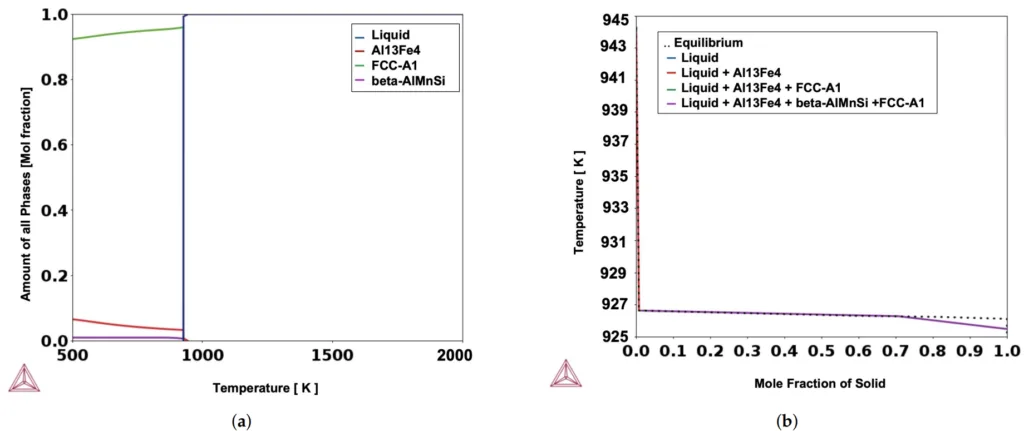
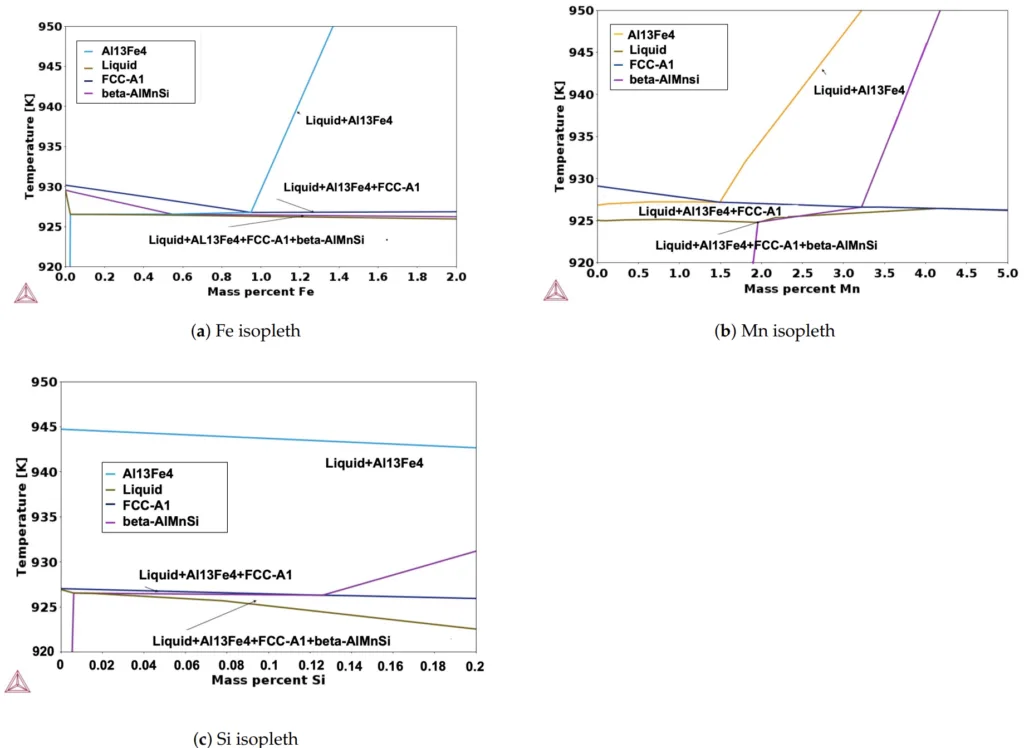
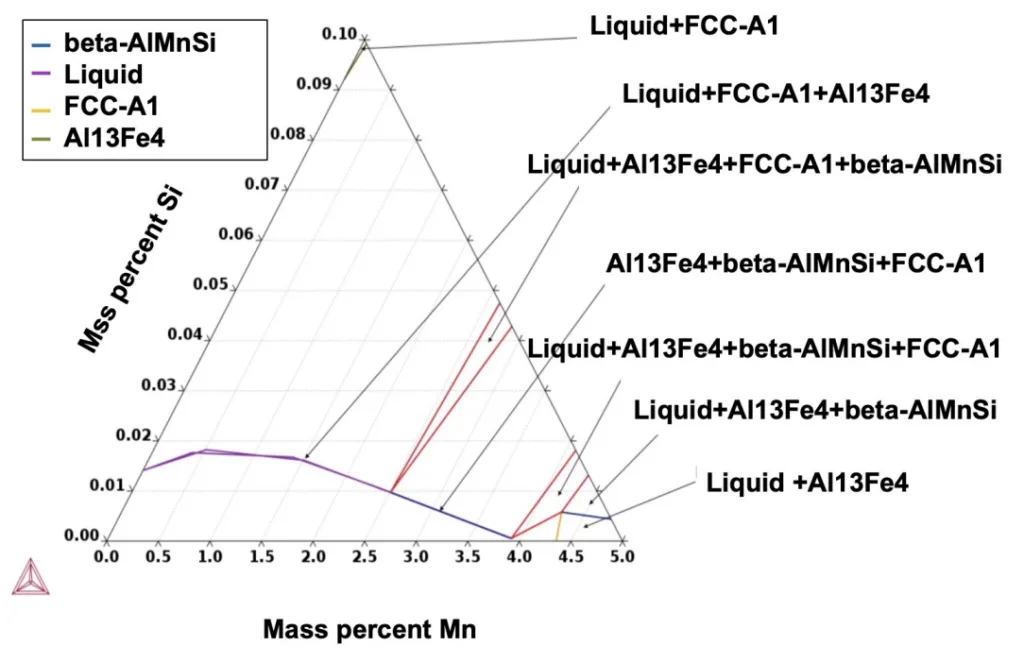
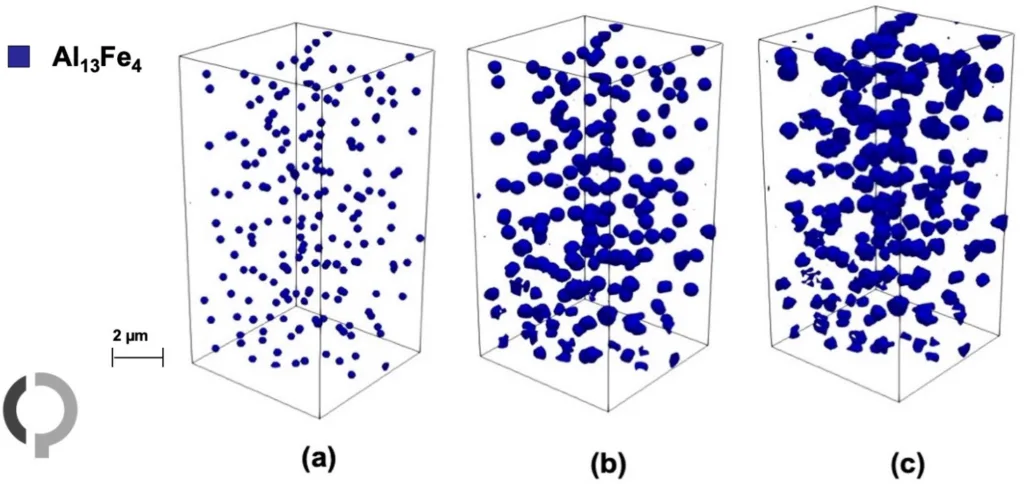
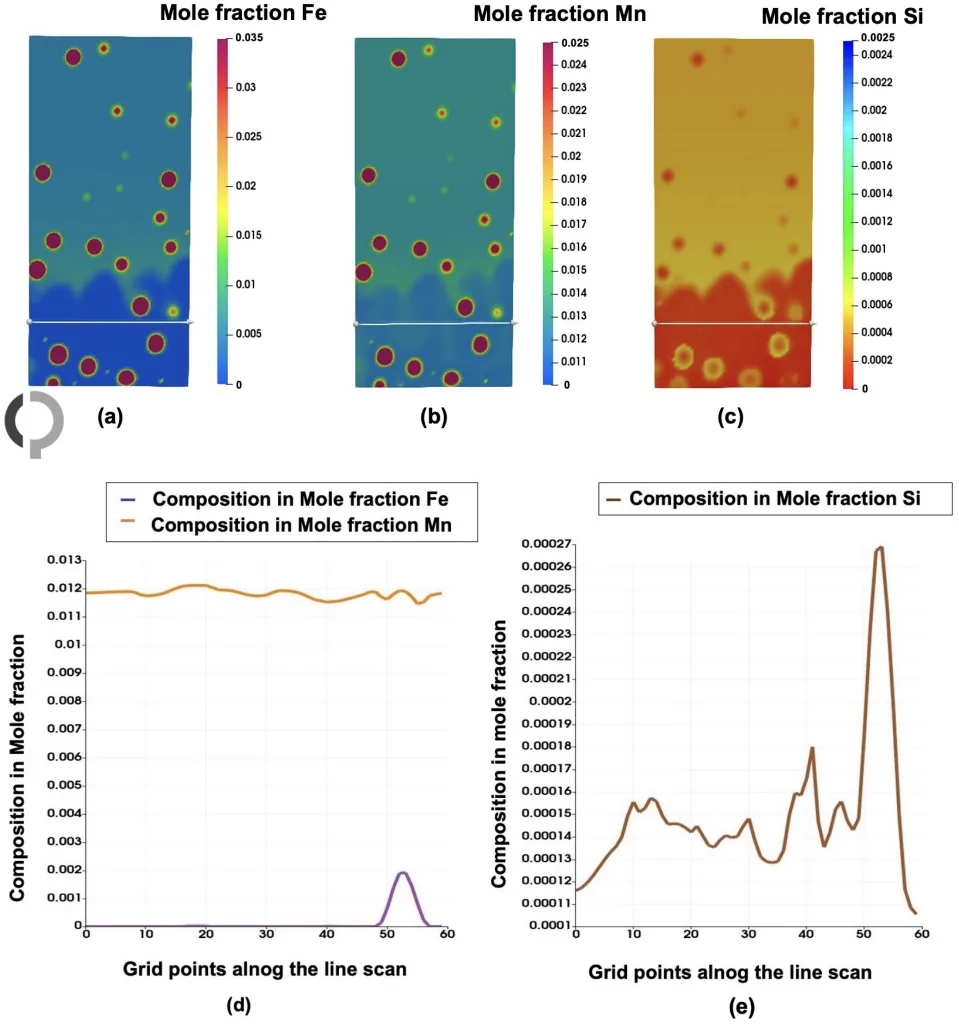
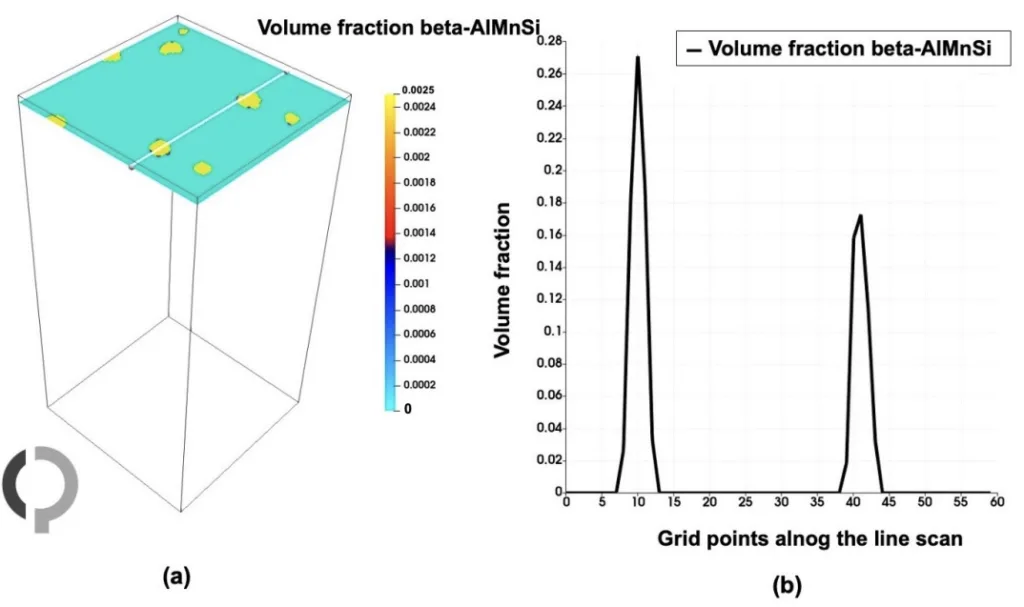
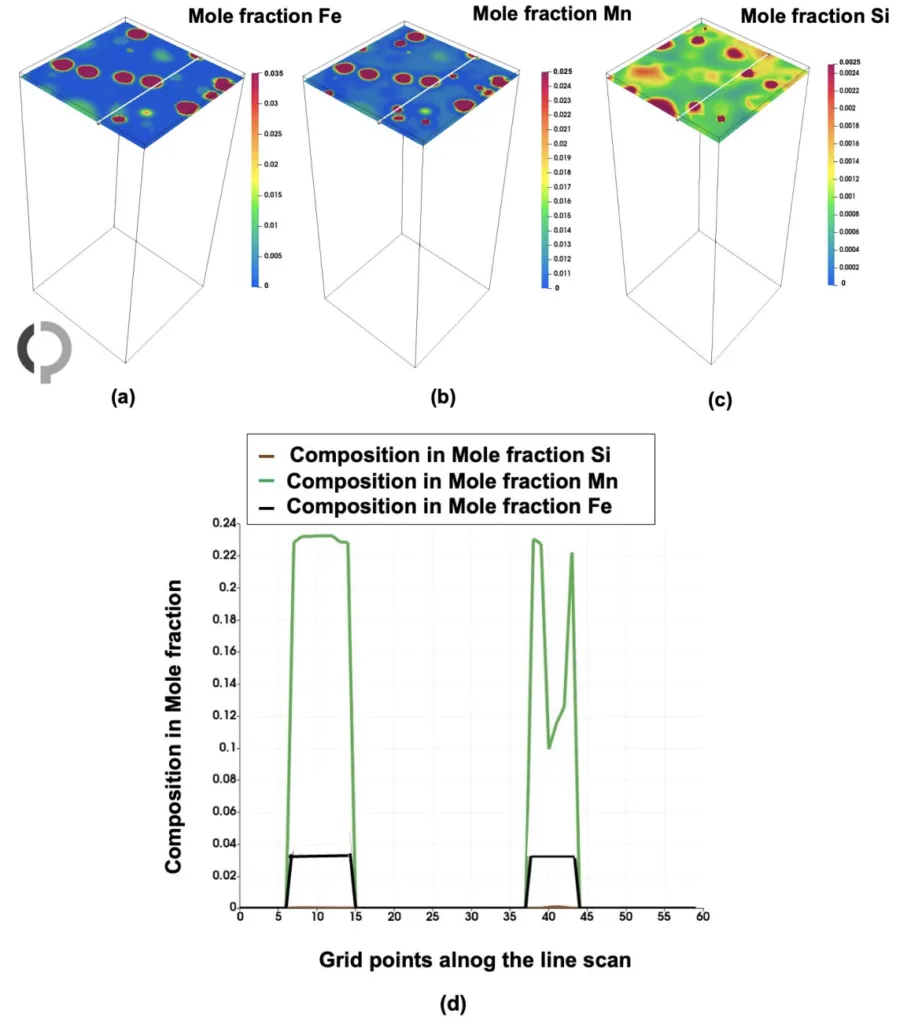
- Figure 1. (a) Al-Fe-Si三元系および (b) Al-Mn-Si三元系の液相線投影図 [28]。
- Figure 2. 安定相分率の計算: (a) 表3の元素割合に基づく温度の関数としての平衡条件下、および (b) 表3の元素含有量に基づくScheil-Gulliver凝固を使用。
- Figure 3. 等組成断面図(a〜c)は、過冷却液体からのFCC-A1、Al13Fe4、およびfi-AlMnSiの核生成と成長を示しています。X軸は、温度に対する(a)Fe、(b)Mn、(c)Siの化学組成を表します。
- Figure 4. FCC-A1、Al13Fe4、およびベータ-AlMnSiと、Al-Fe-Mn-Si合金系の液体(MnおよびSi元素はアルミニウムリッチコーナーの三角形の辺にあります)。
- Figure 5. (a) t0 = 0.0195 sでのAl13Fe4の核生成、(b) t1 = 0.031 sでのこの析出物の成長、(c) t2 = 0.052 sでの析出物の完了。
- Figure 6. (a) t0 = 0.0255 sでのFCC-A1の核生成、(b) t1 = 0.031 sでのこの相の成長、(c) t2 = 0.052 sでの固相の完了。
- Figure 7. (a) t0 = 0.039 sでのベータ-AlMnSiの核生成、(b) t1 = 0.04 sでのこの相の成長、(c) t2 = 0.052 sでの相の完了。
- Figure 8. 方向凝固中の多成分Al-Fe-Mn-Si系の微細組織進化(共晶反応による4つの異なるタイムステップ):(a) t0 = 0.0255 s、(b) t1 = 0.032 s、(c) t2 = 0.039 s、(d) t3 = 0.052 s、Al13Fe4(濃い青)、FCC-A1(薄い青)、およびベータ-AlMnSi(オレンジ)の相分率をマルチフェーズフィールドシミュレーションで示す。
- Figure 9. 多成分Al-Fe-Mn-Si系におけるすべての溶質成分の濃度分布((a) Fe、(b) Mn、(c) Si、t = 0.04 s)。(d) 相情報を含む形態を右側に示す。
- Figure 10. (a) 白線に沿ったAl13Fe4の体積分率のラインスキャン。(b) Al13Fe4と液相の体積分率を示す。
- Figure 11. Al-Fe-Mn-Si系における溶質元素のラインスキャン(Al13Fe4相と液相に沿った特定のタイムステップ、白線で示す)。(a〜c) Fe、Mn、Siのモル分率をそれぞれ示す。(d,e) FeとMnが偏析し、Siが枯渇している相の存在を強調する。
- Figure 12. (a) 白線に沿った液体の体積分率のラインスキャン。(b) FCC-A1と液相の体積分率を示す。
- Figure 13. Al-Fe-Mn-Si系における溶質元素のラインスキャン(FCC-A1相と液相に沿った特定のタイムステップ、白線で示す)。(a〜c) Fe、Mn、Siのモル分率をそれぞれ示す。(d,e) FeとMnが枯渇し、Siが偏析している相の存在を強調する。
- Figure 14. (a) 白線に沿ったベータ-AlMnSiの体積分率のラインスキャン。(b) ベータ-AlMnSi相の体積分率を示す。
- Figure 15. Al-Fe-Mn-Si系における溶質元素のラインスキャン(ベータ-AlMnSi相に沿った特定のタイムステップ、白線で示す)。(a〜c) Fe、Mn、Siのモル分率をそれぞれ示す。(d) Feが枯渇し、SiとMnが偏析している相の存在を強調する。
7. 結論:
主な知見の要約:
方向凝固条件下での多成分Al-Fe-Mn-Si系の共晶凝固形態を、CALPHAD熱力学データベースと結合したマルチフェーズフィールドモデルを用いて調査しました。3D微細組織選択マップは、金属間化合物Al13Fe4、一次共晶FCC-A1、および四元系ベータ-AlMnSiの3つの異なる固相の形成を明らかにしています。凝固はAl13Fe4の核生成から始まり、続いてFCC-A1の成長、そして最後に過飽和液体中のベータ-AlMnSiの核生成が起こります。元素分布分析は、Al13Fe4中のFeとMnの偏析、FCC-A1中のSi、およびベータ-AlMnSi中のMnとSiの濃縮とFeの枯渇を示しています。ラインスキャンは、ベータ-AlMnSi中のFeの枯渇と、異なる相にわたるFe、Mn、およびSiの明確な偏析挙動を確認しています。
研究の学術的意義:
本研究は、高度なフェーズフィールドシミュレーションを用いて、複雑な四元系Al-Fe-Mn-Si合金系における共晶凝固プロセスの詳細な理解を提供します。この研究は、マルチフェーズフィールドモデルが、CALPHADデータベースと組み合わせて、多成分合金における微細組織の進化と元素偏析を予測および分析する能力を実証することに成功しました。この知見は、特に四元相の形成に関して、複雑な合金系における相変態と凝固速度論の基礎知識を深めます。
実際的な意義:
開発された微細組織選択マップと、相形成および元素偏析に関する洞察は、Al-Fe-Mn-Si合金の設計と加工を最適化するために活用できます。各合金元素の役割と相形成の順序を理解することは、微細組織を制御し、ダイカストアルミニウム合金の機械的特性を向上させるのに役立ちます。これは、鉄が一般的な不純物であり、Al13Fe4のような金属間化合物の形成が性能に大きな影響を与えるリサイクルアルミニウム合金に特に関連しています。この研究は、ダイカスト業界の合金設計者およびプロセスエンジニアに計算ツールと知識ベースを提供します。
研究の限界と今後の研究分野:
さまざまな相にわたる界面異方性の影響を定量化するには、さらなる研究が必要です。さらに、本研究のシミュレーションは、実験データと熱力学的モデリング結果の両方を参照して設計されました。ただし、得られたシミュレーション結果は、同じ合金組成で実施された実験的研究を通じて直接検証する必要があります。今後の研究では、シミュレーション結果の実験的検証と、界面異方性およびより詳細な速度論的データを組み込むことによるモデルのさらなる改良に焦点を当てる可能性があります。より広範囲の合金組成と凝固条件を調査することも有益です。
8. 参考文献:
- [1] Chen, H.L.; Chen, Q.; Engström, A. Development and applications of the TCAL aluminum alloy database. Calphad 2018, 62, 154-171.
- [2] Otani, L.B.; Soyama, J.; Zepon, G.; Costa e Silva, A.; Kiminami, C.S.; Botta, W.J.; Bolfarini, C. Predicting the formation of intermetallic phases in the Al-Si-Fe system with Mn additions. J. Phase Equilibria Diffus. 2017, 38, 298-304.
- [3] Zolotorevsky, V.S.; Belov, N.A.; Glazoff, M.V. Casting Aluminum Alloys; Elsevier: Amsterdam, The Netherlands, 2007; Volume 12.
- [4] Callegari, B.; Lima, T.N.; Coelho, R.S. The influence of alloying elements on the microstructure and properties of Al-Si-based casting alloys: A review. Metals 2023, 13, 1174.
- [5] Tian, N.; Wang, G.; Zhou, Y.; Liu, C.; Liu, K.; Zhao, G.; Zuo, L. Phase Formation and Microstructure Evolution of Al-5Si-0.8 Mg Alloys with Different Mn Concentrations. Metals 2021, 11, 308.
- [6] Zhenjie, C.; Haichang, J.; Duo, Z.; Qijuan, D.; Junjun, P.; Luanluan, J. Influence of Mn on the precipitates in 6082 aluminum alloy. J. Mater. Sci. 2024, 59, 9734-9748.
- [7] Li, Q.; Wang, J.; Xue, C.; Wang, S.; Yang, X.; Tian, G.; Su, H.; Li, X.; Miao, Y. Transforming detrimental intermetallics by accumulative thermal and strain energies in the Al-Fe-Si alloy. J. Mater. Sci. 2024, 59, 1699–1720.
- [8] Moore, E.; Turchi, P.; Lordi, V.; Weiss, D.; Sims, Z.; Henderson, H.; Kesler, M.; Rios, O.; McCall, S.; Perron, A. Thermodynamic Modeling of the Al-Ce-Cu-Mg-Si System and Its Application to Aluminum-Cerium Alloy Design. J. Phase Equilibria Diffus. 2020, 41, 764-783.
- [9] Liu, G.; Müller, D.B. Addressing sustainability in the aluminum industry: A critical review of life cycle assessments. J. Clean. Prod. 2012, 35, 108-117.
- [10] Shabestari, S. The effect of iron and manganese on the formation of intermetallic compounds in aluminum-silicon alloys. Mater. Sci. Eng. A 2004, 383, 289–298.
- [11] Wang, E.; Hui, X.; Chen, G. Eutectic Al-Si-Cu-Fe-Mn alloys with enhanced mechanical properties at room and elevated temperature. Mater. Des. 2011, 32, 4333-4340.
- [12] Liu, C.; Garner, A.; Zhao, H.; Prangnell, P.B.; Gault, B.; Raabe, D.; Shanthraj, P. CALPHAD-informed phase-field modeling of grain boundary microchemistry and precipitation in Al-Zn-Mg-Cu alloys. Acta Mater. 2021, 214, 116966.
- [13] Liu, C.; Davis, A.; Fellowes, J.; Prangnell, P.B.; Raabe, D.; Shanthraj, P. CALPHAD-informed phase-field model for two-sublattice phases based on chemical potentials: η-phase precipitation in Al-Zn-Mg-Cu alloys. Acta Mater. 2022, 226, 117602.
- [14] Zhang, F.; Liang, S.; Zhang, C.; Chen, S.; Lv, D.; Cao, W.; Kou, S. Prediction of cracking susceptibility of commercial aluminum alloys during solidification. Metals 2021, 11, 1479.
- [15] Jha, R.; Dulikravich, G.S. Temperature Regimes and Chemistry for Stabilizing Precipitation Hardening Phases in Al-Sc Alloys: Combined CALPHAD-Deep Machine Learning. ASME Open J. Eng. 2022, 1. spanning 12 pages.
- [16] Jreidini, P.; Pinomaa, T.; Wiezorek, J.M.; McKeown, J.T.; Laukkanen, A.; Provatas, N. Orientation gradients in rapidly solidified pure aluminum thin films: comparison of experiments and phase-field crystal simulations. Phys. Rev. Lett. 2021, 127, 205701.
- [17] Chen, J.; Guo, M.; Yang, M.; Cui, T.; Cui, B.; Zhang, J. Insight into element segregation mechanisms during creep in γ'-strengthened Co-based superalloy by elastoplastic phase-field simulation. Prog. Nat. Sci. Mater. Int. 2024, 34, 873–879.
- [18] Liu, X.; Shen, W.; Liu, W. Phase-Field Simulation of Precipitation and Grain Boundary Segregation in Fe-Cr-Al Alloys under Irradiation. Nanomaterials 2024, 14, 1198.
- [19] Gong, T.Z.; Chen, Y.; Hao, W.Y.; Chen, X.Q.; Li, D.Z. Modeling segregation of Fe-C alloy in solidification by phase-field method coupled with thermodynamics. Metals 2023, 13, 1148.
- [20] Staublin, P.; Mukherjee, A.; Warren, J.A.; Voorhees, P.W. Phase-field model for anisotropic grain growth. Acta Mater. 2022, 237, 118169.
- [21] Steinbach, I. Phase-field models in materials science. Model. Simul. Mater. Sci. Eng. 2009, 17, 073001.
- [22] Ji, Y.; Ghaffari, B.; Li, M.; Chen, L.Q. Phase-field modeling of e' precipitation kinetics in 319 aluminum alloys. Comput. Mater. Sci. 2018, 151, 84-94.
- [23] Provatas, N.; Elder, K. Phase-Field Methods in Materials Science and Engineering; John Wiley & Sons: Hoboken, NJ, USA, 2011.
- [24] Jokisaari, A.M.; Voorhees, P.W.; Guyer, J.E.; Warren, J.A.; Heinonen, O.G. Phase field benchmark problems for dendritic growth and linear elasticity. Comput. Mater. Sci. 2018, 149, 336-347.
- [25] Biswas, S.; Schwen, D.; Singh, J.; Tomar, V. A study of the evolution of microstructure and consolidation kinetics during sintering using a phase field modeling based approach. Extrem. Mech. Lett. 2016, 7, 78–89.
- [26] Biswas, S.; Schwen, D.; Tomar, V. Implementation of a phase field model for simulating evolution of two powder particles representing microstructural changes during sintering. J. Mater. Sci. 2018, 53, 5799–5825.
- [27] Militzer, M. Phase field modeling of microstructure evolution in steels. Curr. Opin. Solid State Mater. Sci. 2011, 15, 106–115.
- [28] Lacaze, J.; Eleno, L.; Sundman, B. Thermodynamic assessment of the aluminum corner of the Al-Fe-Mn-Si system. Metall. Mater. Trans. A 2010, 41, 2208-2215.
- [29] Warmuzek, M.; Ratuszek, W.; Sęk-Sas, G. Chemical inhomogeneity of intermetallic phases precipitates formed during solidification of Al-Si alloys. Mater. Charact. 2005, 54, 31-40.
- [30] Allen, C.; O'reilly, K.; Cantor, B.; Evans, P. Intermetallic phase selection in 1XXX Al alloys. Prog. Mater. Sci. 1998, 43, 89–170.
- [31] Arbeiter, J.; Vončina, M.; Volšak, D.; Medved, J. Evolution of Fe-based intermetallic phases during homogenization of Al-Fe hypoeutectic alloy. J. Therm. Anal. Calorim. 2020, 142, 1693–1699.
- [32] Wang, X.; Guan, R.; Misra, R.; Wang, Y.; Li, H.; Shang, Y. The mechanistic contribution of nanosized Al3Fe phase on the mechanical properties of Al-Fe alloy. Mater. Sci. Eng. A 2018, 724, 452-460.
- [33] Ansara, I.; Dinsdale, A.; Rand, M. Thermochemical Database for Light Metal Alloys; Office for Official Publications of the European Communities: Luxembourg, 1998.
- [34] Eleno, L.; Vezelỳ, J.; Sundman, B.; Cieslar, M.; Lacaze, J. Assessment of the Al corner of the ternary Al-Fe-Si system. Mater. Sci. Forum 2010, 649, 523-528.
- [35] Zakharov, A.; Guldin, I.; Arnold, A. Phase Diagram of the Al-Si-Fe-Mn System in the 10-14% Si, 0-3% Fe, and 0-4% Mn Concentration Ranges. (Translation). Russ. Metall. 1989, 209-213. Issue 4.
- [36] Flores-V, A.; Sukiennik, M.; Castillejos-E, A.; Acosta-G, F.; Escobedo-B, J. A kinetic study on the nucleation and growth of the Al8FeMnSi2 intermetallic compound for aluminum scrap purification. Intermetallics 1998, 6, 217-227.
- [37] Onderka, B.; Sukiennik, M.; Fitzner, K. Determination of the stability of Al11. 8FeMn1. 6Si1. 6 phase existing in the quaternary Al-Fe-Mn-Si system. Arch. Metall. 2000, 45, 119–132.
- [38] Munson, D. A clarification of the phases occurring in aluminium-rich aluminium-iron-silicon alloys, with particular reference to the ternary phase alpha-AlFeSi. Inst. Met. J. 1967, 95, 217–219.
- [39] Tibballs, J.; Horst, J.; Simensen, C. Precipitation of a-Al (Fe, Mn) Si from the melt. J. Mater. Sci. 2001, 36, 937–941.
- [40] Steinbach, I.; Pezzolla, F.; Nestler, B.; Seeßelberg, M.; Prieler, R.; Schmitz, G.J.; Rezende, J.L. A phase field concept for multiphase systems. Phys. D Nonlinear Phenom. 1996, 94, 135-147.
- [41] Uddagiri, M.; Shchyglo, O.; Steinbach, I.; Tegeler, M. Solidification of the Ni-based superalloy CMSX-4 simulated with full complexity in 3-dimensions. Prog. Addit. Manuf. 2023, 1-12.
- [42] Wang, Z.; Liang, C.; Wang, D.; Yue, X.; Li, J.; Ding, X. Unveiling the Co effect on the temporal evolution kinetics of γ' phase in Ni-Al-Co model superalloys via CALPHAD-informed phase field simulations. Acta Mater. 2023, 258, 119247.
- [43] Wang, Z.; Liang, C.; Wang, D.; Ding, X. Uncovering the effect of Mo addition on the precipitation kinetics of the y' phase in Ni-Al-Mo model superalloys using CALPHAD-assisted phase-field simulations. J. Mater. Sci. 2024, 1–20.
- [44] Thakur, A.K.; Kovacevic, S.; Manga, V.R.; Deymier, P.A.; Muralidharan, K. A first-principles and CALPHAD-assisted phase-field model for microstructure evolution: Application to Mo-V binary alloy systems. Mater. Des. 2023, 235, 112443.
- [45] Warnken, N.; Ma, D.; Drevermann, A.; Reed, R.C.; Fries, S.; Steinbach, I. Phase-field modelling of as-cast microstructure evolution in nickel-based superalloys. Acta Mater. 2009, 57, 5862-5875.
- [46] Steinbach, I.; Böttger, B.; Eiken, J.; Warnken, N.; Fries, S. CALPHAD and phase-field modeling: A successful liaison. J. Phase Equilibria Diffus. 2007, 28, 101–106.
- [47] Keller, T.; Lindwall, G.; Ghosh, S.; Ma, L.; Lane, B.M.; Zhang, F.; Kattner, U.R.; Lass, E.A.; Heigel, J.C.; Idell, Y.; et al. Application of finite element, phase-field, and CALPHAD-based methods to additive manufacturing of Ni-based superalloys. Acta Mater. 2017, 139, 244-253.
- [48] Tegeler, M.; Shchyglo, O.; Kamachali, R.D.; Monas, A.; Steinbach, I.; Sutmann, G. Parallel multiphase field simulations with OpenPhase. Comput. Phys. Commun. 2017, 215, 173–187.
- [49] Greer, A. Overview: Application of heterogeneous nucleation in grain-refining of metals. J. Chem. Phys. 2016, 145.
- [50] Uddagiri, M.; Shchyglo, O.; Steinbach, I.; Wahlmann, B.; Koerner, C. Phase-field study of the history-effect of remelted microstructures on nucleation during additive manufacturing of ni-based superalloys. Metall. Mater. Trans. A 2023, 54, 1825-1842.
- [51] Park, J.; Oh, C.S.; Kang, J.H.; Jung, J.G.; Lee, J.M. Solidification and Precipitation Microstructure Simulation of a Hypereutectic Al-Mn-Fe-Si Alloy in Semi-Quantitative Phase-Field Modeling with Experimental Aid. Metals 2020, 10, 1325.
- [52] Hallstedt, B.; Khvan, A.V.; Lindahl, B.B.; Selleby, M.; Liu, S. PrecHiMn-4-A thermodynamic database for high-Mn steels. Calphad 2017, 56, 49-57.
- [53] Michael, K.; Philipp, S.; Britta, N.; et al. Applications of the phase-field method for the solidification of microstructures in multi-component systems. J. Indian Inst. Sci. 2016, 96, 235-256.
- [54] Thesis, D. Characterization of equilibrium phases in 8xxx alloys for the optimization of the thermodynamic database for MatCalc. Ph.D. Thesis, Technische Universität Wien, Vienna, Austria, 2022.
- [55] Que, Z.; Fang, C.; Mendis, C.L.; Wang, Y.; Fan, Z. Effects of Si solution in 0-A113Fe4 on phase transformation between Fe-containing intermetallic compounds in Al alloys. J. Alloy. Compd. 2023, 932, 167587.
- [56] Yan, X.; Ding, L.; Chen, S.; Xie, F.; Chu, M.; Chang, Y.A. Predicting microstructure and microsegregation in multicomponent aluminum alloys. In Essential Readings in Light Metals: Volume 3 Cast Shop for Aluminum Production; Springer: Berlin/Heidelberg, Germany, 2016; pp. 512–518.
9. 著作権:
- この資料は、"Kimiya NouraniNiaki"の論文:"Phase Field Simulation of Al–Fe–Mn–Si Quaternary Eutectic Solidification" に基づいています。
- 論文ソース: https://doi.org/10.3390/met15020135
この資料は上記の論文を紹介するために作成されたものであり、商業目的での無断使用は禁止されています。
Copyright © 2025 CASTMAN. All rights reserved.